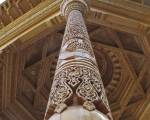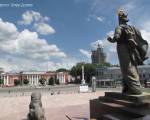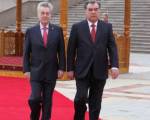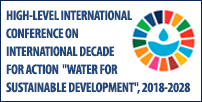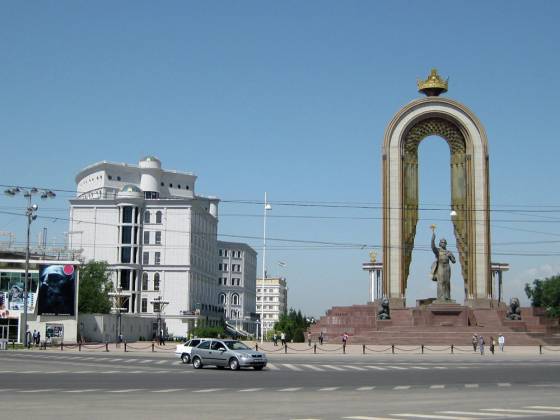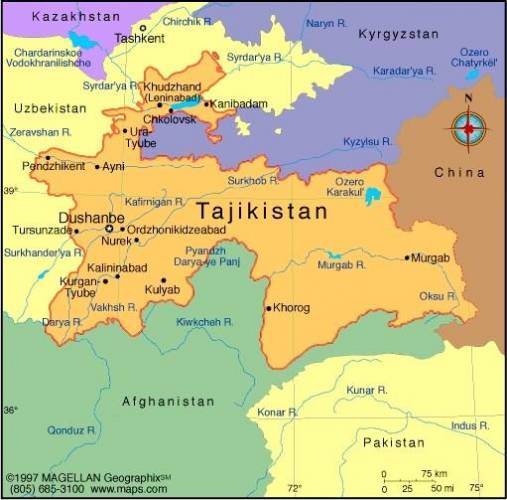General Information
Capital: Dushanbe
Location: South-East of Central Asia
Territory: 143,1 thousand square kilometers
Population: 7,211,884 (July 2008 est.)
Currency: Somoni, introduced in October, 2000
State Borders
Length: 700 kilometers from West to East, 350 kilometers from north to south. In the West and North, Tajikistan has borders with Uzbekistan (910 kilometers) and Kyrgyzstan (630 kilometers); in the South with Afghanistan (1, 030 kilometers), and in the East with China (430 kilometers). Climate: - Continental. January from +220C (Panj) to -610C (Lake Bulunkul), July from -80C (Lake Bulunkul) to +450C (Panj).
Mineral Resources
The mineral resources of Tajikistan contain almost all elements of the Mendeleyev table and are a unique storage of wealth. By this moment, over 400 deposits of mineral resources and ores have been found, explored and prepared for development in Tajikistan. Tajikistan is one of the countries, which possess significant resources of precious metals. A Tajik-British joint venture Zarafshon has been formed and now extracts gold with modern technologies at deposits Jilau, Taror and some others in the Sughd region. In the valley of Zarafshon, there are some other deposits of gold (Chore, Shahbas, and Kum-Manor), that will provide for continues work of gold-mining enterprises.
A Tajik-British joint venture Darvoz works in Khatlon region, to which the government of Tajikistan granted the exclusive right to develop gold mines in Central and South Tajikistan. By information of Academy of Science of Republic of Tajikistan, 28 deposits of gold have been identified in territory of Tajikistan, with total estimated volume 429.3 tons of gold. The Koni Mansur - the world's second large deposit of silver is situated in the north of Tajikistan. With annual extraction of 50 tons of silver, the deposit will last for 150 years.
The resources of antimony in Tajikistan are the largest in CIS. The largest deposit -"Skalnoye" - contains about 50% of the silver ore of the CIS. With intensive development, this deposit would yield 800 tons of ore during 45 years and would be the monopolist in extraction and processing of antimony in the Commonwealth. The Sughd region, apart from antimony and mercury resources, is the location of 214 deposits of other mineral resources, such as lead, zinc (16 deposits), copper, bismuth (3), molybdenum, tungsten (1), strontium (2), iron (3), gold (15), silver (7), lead (1), coal (11), oil and gas (11), spat (5), salt (1), etc. The Uchkado deposit is unique with its contents of gold, silver, zinc, antimony and lead. The cost of the metals here is estimated at more than $10 billion. It is the only deposit of this type in the world. In the north of Tajikistan are endless deposits of construction and decorative materials: marble, granite, volcanic tuff, limestone, and mineral springs. Of great importance are deposits of coal at Kshtut-Zauran and Fon-Yaghnob - the coal here can be processed into the cheapest liquid and gas fuel at about $120-$130 per ton.
The coal extraction here would last for 200 years. In Central Tajikistan, 95 km of Dushanbe, a tungsten deposit Maykhura has been discovered. The resources of ore would provide for profitable production of 150,000 tons of ore annually. Deposits of a rare metal - strontium have been found in Khatlon region. The strontium salts are widely used in metallurgy, atomic, chemical and pharmaceutical industries. The overall resources of strontium at Chaltash, Daudyr and Chikultan can provide for annual production of 180,000 tons of ore. In the same area large lead-and-zinc fields have been revealed. The largest one - in Baljuvon is estimated at 1.2 million tons of lead and 1.2 million tons of zinc.
The south of the republic is the location of resources of salt. The Khoja-Mumin, Khoja-Sartez, Tanobchi and Samanchi deposits contain dozens of billions of tons of salt. Mountainous Badakhshon - the severe region with harsh climate is the area of deposits of gold, silver, copper, tungsten, mica and precious stones. The republic's only deposit of boron is located at Ak-Arkhar. Resources of datolit and danburit ores are estimated at 7.4 million tons.
Mining and Minerals
Underneath Tajikistan's ever-present mountains lie a wide array of natural resources, many of which have not yet been exploited because of their geographical location or geological depth. For its size, Tajikistan is relatively blessed with silver and gold deposits. Total silver ore deposits are estimated at 60,000 tons and the largest, in Koni Mansur, is around 38,000 tons. There are more than 30 known gold deposits, of which only a few have been prospected. Several potentially important coal deposits have been identified but have not yet been exploited. May of the mineral deposits are suitable for relatively inexpensive open-pit mining, but they are found in mountainous regions where extreme weather conditions prevail and transportation routes are difficult or non-existent. There is some coal extraction at the Yaghnob mine in the Sughd Region, while a number of other coal deposits have not yet been exploited. A large antimony deposit has been discovered in the Khovland district southeast of Dushanbe. Japan has tentatively agreed to provide financing for the mine with an initial sum of $2 million earmarked for planning and feasibility study.
Aluminum
During the Soviet era, Tajikistan was famous for its aluminum smelter. The largest enterprise in Tajikistan, the Tursunzoda Aluminum Smelter (TadAZ) is in the south-west of the country. It has an overall capacity of over 520,000 tons a year and accounting for 53 percent of total exports making it one of the largest in the world. Tajikistan produced 131,900 tons of aluminum and earned $210 million in export revenues. However, This is small compared with 450,000 tons in 1990. The aluminum is exported to countries including the Netherlands, Finland, England, Hungary, South Korea, Turkey and Belgium.
Among NIS countries, Russia and Turkmenistan are the largest importers of Tajik aluminum. An estimated 5,000 tons of aluminum was consumed domestically to produce kitchenware and other household necessities. Tursunzoda consumes nearly 40 percent of the total power output in the country, employs 12,000 workers and indirectly supports a community of 100,000. It has a capacity of 520,000 tons and accounts for more than 30 percent of total exports. By 2005 Tursunzoda plans to increase its production levels to 346,000 tons.
The only downstream industries at present are a cable and foil plant. Aluminum is one of the two main exports. The government is seeking foreign investment in the aluminum plant itself as well as opportunities for downstream projects. There have been instances of fighting near the plant as different factions have tried to assert control over the plant's production and lucrative exports. The Government of Tajikistan has decided to include the plant in its privatization program. The government would retain a controlling block of shares, while the remaining assets could be purchased by foreign investors. The plant has, however, accumulated an estimated $120 million in debt to foreign creditors, which is likely to make it less attractive to foreign investors.
Silver and Gold
Tajikistan produced 1.5 tons of gold during the first eight months of 2000, a 15 percent increases over the same period in 1999 and worth about $35.8 million. Tajikistan has big plans for its silver sector. The country has plans to establish a joint venture with Indian companies to develop the Koni Mansur silver deposit. The Indian companies plan to inject US $ 100 million into the deposit, which is home to 53,000 tons of silver.
Energy
Tajikistan is the world's third largest producer of hydroelectric power after the U.S. and Russia. Hydroelectric generation accounts for 76 percent of total energy output in the country. Energy consumption per capita is among the lowest in the NIS. An estimated 3,908 million kWh of electricity was exported from Tajikistan in 2000. Tajikistan is also an importer of electricity and in 2000 imported electricity, which amounted to an estimated 5242.3 million kWh. Imports of energy for Tajikistan will be on the rise from the effects of the drought in 2000 causing a drop in the water level at the reservoir serving the largest hydroelectric power station in all of Central Asia, Norak.
Another major power station, is the Roghun dam which is under construction. Roghun is designed to have a capacity of 3,600 megawatts, which would produce an average annual output of 13.3 billion kilowatt hours. The Government of Tajikistan is anxious to identify foreign financing to finish the construction of the Roghun complex to address the country's critical energy shortages that result in only a few hours a day of electricity in the winter and has shut down much of the country's industry. Hydroelectric energy is key for the future of economic growth for Tajikistan because of the country's high need to import oil and natural gas from its neighboring countries, and the energy consumption alone of the TALCO aluminum company.
Tajikistan also consumes significant quantities of oil, natural gas and coal but is self-sufficient for less than 50 percent of its total energy needs. Uzbekistan alone supplies more than 70 percent Tajikistan's petroleum needs. Other CIS countries such as Kazakhstan and Turkmenistan provide another 27 percent. In 2000 Tajikistan imported 187,000 tons in petroleum products and 646,000 cubic meters of natural gas. The government has identified several gas fields for development, is seeking foreign investors, and has held talks with Iran for assistance in the oil sector.




